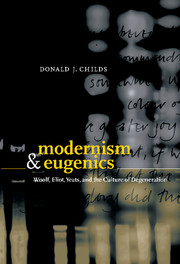Book contents
- Frontmatter
- Contents
- Introduction
- Chapter 1 Virginia Woolf's hereditary taint
- Chapter 2 Boers, whores, and Mongols in Mrs. Dalloway
- Chapter 3 Body and biology in A Room of One's Own
- Chapter 4 Eliot on biology and birthrates
- Chapter 5 To breed or not to breed: the Eliots' question
- Chapter 6 Fatal fertility in The Waste Land
- Chapter 7 The late eugenics of W.B. Yeats
- Chapter 8 Yeats and stirpiculture
- Chapter 9 Yeats and The Sexual Question
- Notes
- Index
Chapter 7 - The late eugenics of W.B. Yeats
Published online by Cambridge University Press: 22 September 2009
- Frontmatter
- Contents
- Introduction
- Chapter 1 Virginia Woolf's hereditary taint
- Chapter 2 Boers, whores, and Mongols in Mrs. Dalloway
- Chapter 3 Body and biology in A Room of One's Own
- Chapter 4 Eliot on biology and birthrates
- Chapter 5 To breed or not to breed: the Eliots' question
- Chapter 6 Fatal fertility in The Waste Land
- Chapter 7 The late eugenics of W.B. Yeats
- Chapter 8 Yeats and stirpiculture
- Chapter 9 Yeats and The Sexual Question
- Notes
- Index
Summary
To judge by the story of Yeats and eugenics told by several scholars, chief among them Elizabeth Cullingford, Paul Scott Stanfield, and David Bradshaw, Yeats was the last of the three writers I discuss to engage with eugenical discourse in a serious way. Although acknowledging Yeats's longstanding concerns about degeneration, they agree that he becomes a full-blown eugenist only in the 1930s. In acknowlegdment of this consensus, I have postponed consideration of the eugenical Yeats until after having aired the question of the eugenical interests of Woolf and Eliot – interests dating from much earlier in the century. My suggestion, however, is that Yeats was not the last of these writers to become interested in eugenics, but the first.
There can be no doubt about Yeats's interest in eugenics in the late 1930s. In On the Boiler (1939), his most explicitly eugenical work, Yeats pulls no punches. What he calls the “mob” does not need to know how to read and write: “Forcing reading and writing on those who wanted neither was the worst part of the violence which for two centuries has been creating that hell wherein we suffer.”
- Type
- Chapter
- Information
- Modernism and EugenicsWoolf, Eliot, Yeats, and the Culture of Degeneration, pp. 149 - 169Publisher: Cambridge University PressPrint publication year: 2001



